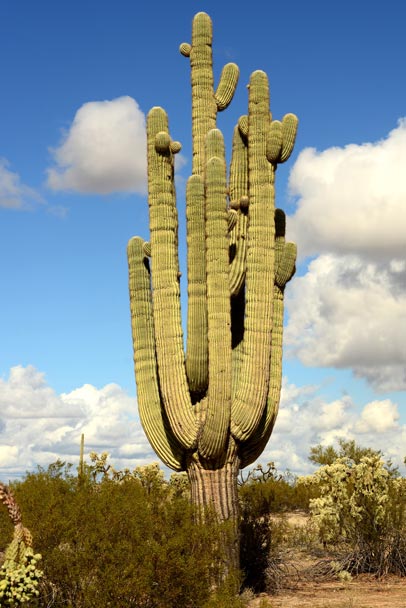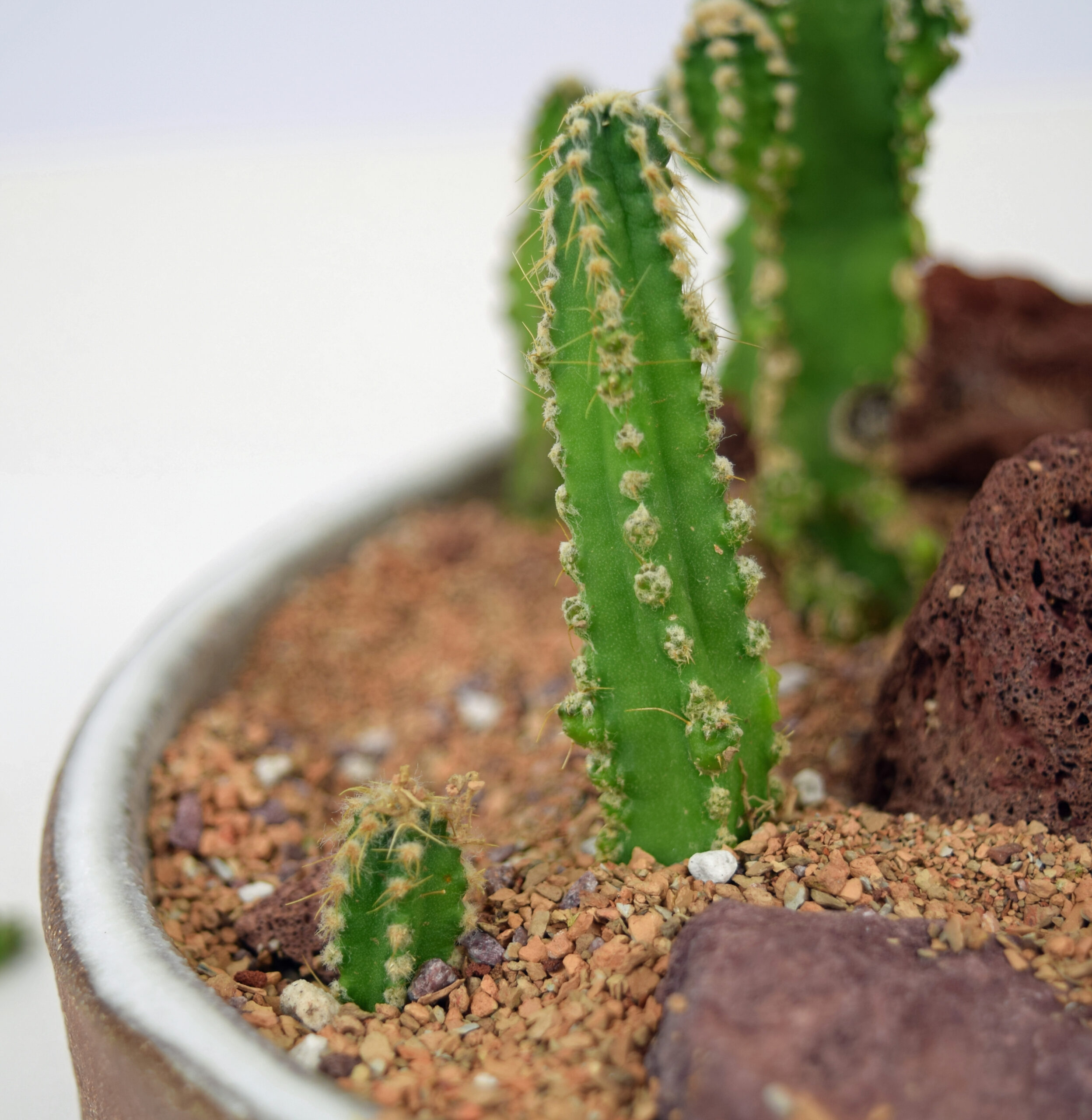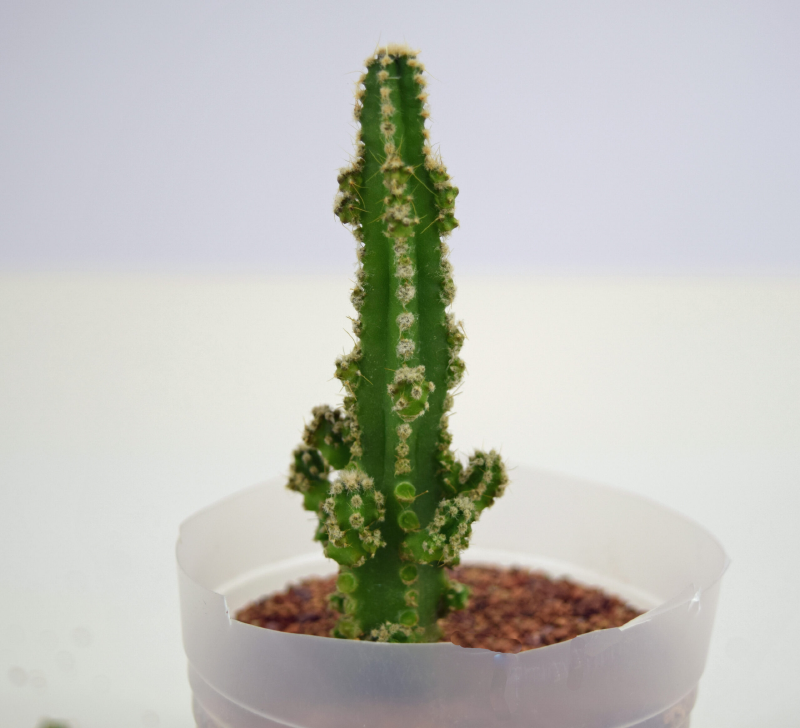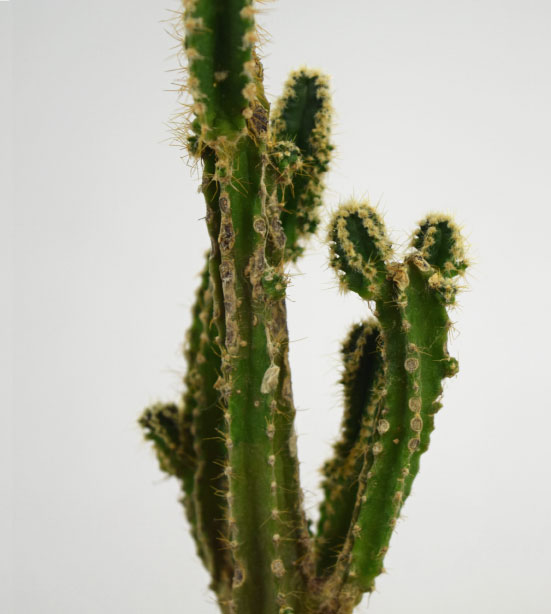Shape and Style
Saguaro Growth Pattern
Cactuscape attempts to portray the look of the giant Saguaro cactus on a miniature scale. To do so, we must understand the natural growth pattern of the Saguaro so we can emulate with our little plants.
Fortunately, the Saguaro tend to grow in a relatively uniform growth pattern (although there is much natural variation).

The trunk of the Saguaro grows straight and vertical. Rarely is a cactus found growing at an angle or curved. They start out as a single stalks (called “spikes”), and do not start growing the distinctive “arms” until they have reached a significant height.

Once the spike is large enough, it starts to grow buds in a sort of ring around the trunk. These buds grow into the arms encircling the trunk in a ring. This “main ring” most often occurs at a point about 1/4 to 1/2 (usually 1/3) up the fully grown trunk.

The arms continue growing out away from the trunk, until they reach about two thirds up the trunk.This is the classic look of the Saguaro cactus.

As the cactus ages, it will often start budding from other points on the main trunk. (They rarely grow secondary buds out of the arms.)
From this growth pattern one can tell the relative age of a cactus. (This one is about 40 ft tall, and 150+ years old.)

For example, here is a very old (and large) Saguaro. Notice the many arms, which all branch directly from the trunk.
While Saguaro tend towards the growth pattern above, during their long lives they are subject to environmental and genetic factors which can result in many unique and unusual shapes:





Shaping the Cactuscape Cactus
Shaping the Cactuscape Cactus
 The cactus we use for Cactuscape (Acanthocerus Tetragonus – Fairy Castle) have a slightly different growth pattern than the Saguaro, but it can be modified to approximate that of the Saguaro. The main difference is that the Cactuscape cactus grow buds much more profusely than Saguaro, including lower down on the trunk and from secondary branches.
The cactus we use for Cactuscape (Acanthocerus Tetragonus – Fairy Castle) have a slightly different growth pattern than the Saguaro, but it can be modified to approximate that of the Saguaro. The main difference is that the Cactuscape cactus grow buds much more profusely than Saguaro, including lower down on the trunk and from secondary branches.
To approximate the look of the Saguaro, we shape our Cactuscape cactus by pinching off the “extra” buds where we don’t want them to grow into arms, and allowing buds to grow where we do want them to grow into arms.
The first step is to plan the height of the “main ring” of arms.
The main ring is a spot approximately 1/3 the height of the (intended) fully grown plant. For example, if you intend the plant to grow to be 9″ tall, the main ring would be located approximately 3″ high (1/3 the intended height), although there is plenty of variation from 1/4 to 1/2 up the trunk.
This is usually a spot in that area which already has some buds growing, and allow those buds to grow in to arms. Try to find a spot in the lower part of the plant which already has a bud or two growing at the right height. Ideally there is one bud growing from each rib at the same level making a ring, but this hardly ever happens. Usually there are one or two buds at the right height (which is enough), and other buds nearby on the other ribs which can be used as well.
For example, if you have a small cactus and want it to grow to a final height of 9 inches, the main ring would be at about 3 inches, so buds in that area are retained:

On the small cactus below there is a large bud growing from the bottom. This bud is much lower than the main ring will be, so it can be removed. Remove it by plucking it off with a gentle twisting motion.

Plucking off bud

Plucking off bud

If you want you can try to propagate the bud into a new plant. Just let it dry for a few days, and then replant it right back in the same pot. There is a good chance it will root and grow into a new cactus.
However, do not remove too many buds all at once, or it could weaken or kill the plant. Perform thinning on the buds over time to preserve the strength of the plant and eventually leave only the buds you want.


Before thinning

After thinning
One difference in growth between Cactuscape plants and the Saguaro is that the Saguaro mainly send new buds from the trunk (no buds from the arms themselves). However our Cactuscape plants frequently do send secondary buds from the arms, which should be plucked off. If one cannot find buds at exactly the same level on all the ribs, find the next closest bud, or leave that rib empty.

Cactuscape cactus with buds from arms

Close up of buds on arms

Cactus with buds removed from arms

Saguaro showing no buds from arms for comparison

Remember
There is plenty of variation in nature, so there can (and should) be variation in our Cactuscape plantings.

Shaping the Cactuscape Cactus
Bending
While the Cactuscape cactus tend to grow vertically, they do not do so as consistently as the Saguaro. It is not unusual for the trunk to curve (usually to follow a light source) or to make a twist or have other irregularities. One way to encourage them to grow straight is to gently bend them into the desired shape. This is done VERY gently, with the goal of stretching the cactus on one side or the other to achieve the desired shape.

One gently stretches the cactus into the desired shape, and holds it there for about 5-10 seconds. Upon releasing, the cactus will usually return towards it’s previous shape, but not as far. If this process is done once a week for 4 weeks, the cactus will usually start retaining the desired shape.

This technique is also useful for bending the arms away from trunk to make them look more distinctive. If done on the arms, be careful to support the arm from below, and not bend it at the joint with the trunk so it does not break off from the trunk.

